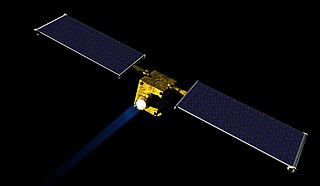Astronomical year numbering is based on AD/CE year numbering, but follows normal decimal integer numbering more strictly. Thus, it has a year 0; the years before that are designated with negative numbers and the years after that are designated with positive numbers. Astronomers use the Julian calendar for years before 1582, including the year 0, and the Gregorian calendar for years after 1582, as exemplified by Jacques Cassini (1740), Simon Newcomb (1898) and Fred Espenak (2007).

Astrobiology, formerly known as exobiology, is an interdisciplinary scientific field concerned with the origins, early evolution, distribution, and future of life in the universe. Astrobiology considers the question of whether extraterrestrial life exists, and if it does, how humans can detect it.

The Jet Propulsion Laboratory (JPL) is a federally funded research and development center and NASA field center in La Cañada Flintridge, California, United States, though it is often referred to as residing in Pasadena, California, because it has a Pasadena ZIP Code.

NASA's Discovery Program is a series of lower-cost, highly focused American scientific space missions that are exploring the Solar System. It was founded in 1992 to implement then-NASA Administrator Daniel S. Goldin's vision of "faster, better, cheaper" planetary missions. Discovery missions differ from traditional NASA missions where targets and objectives are pre-specified. Instead, these cost-capped missions are proposed and led by a scientist called the Principal Investigator (PI). Proposing teams may include people from industry, small businesses, government laboratories, and universities. Proposals are selected through a competitive peer review process. All of the completed Discovery missions are accomplishing ground-breaking science and adding significantly to the body of knowledge about the Solar System.
The Planetary Observer program is a cancelled space exploration program designed by NASA to provide cheaper planetary orbiters by using Earth-orbiting satellite components and technology, using solar panels for power, and a common spacecraft bus platform for all Planetary Observer-class probes. Only one spacecraft of this class was eventually constructed—the Mars Observer.
ǃXu, also ǃXu꞉ba and sometimes ǃXo or ǃXo꞉ba, is a San rendering of the Khoikhoi word ǃKhu 'rich' and its derivation ǃKhub 'rich man, master', which was used by some Christian missionaries to the Khoikhoi to translate the word "Lord" in the Bible. Bleek reports that the ǂKxʼaoǁʼae rendered the word as ǃXo and the Naro as ǃXu꞉ba or ǃXo꞉ba when repeating things what the Khoikhoi had told them. It has entered the Juǀʼhoan language as the name of the Christian god.

NGC 7027 is a very young and dense planetary nebula located around 3,000 light-years from Earth in the constellation Cygnus. Discovered in 1878 by Édouard Stephan using the 800 mm (31 in) reflector at Marseille Observatory, it is one of the smallest planetary nebulae and by far the most extensively studied. Helium hydride was detected in the nebula in 2019, the first discovery of that molecule in space.
Ben J. Bussey is an American planetary scientist.

SIMBAD is an astronomical database of objects beyond the Solar System. It is maintained by the Centre de données astronomiques de Strasbourg (CDS), France.
The Lunar and Planetary Institute (LPI) is a scientific research institute dedicated to study of the solar system, its formation, evolution, and current state. The Institute is part of the Universities Space Research Association (USRA) and is supported by the Science Mission Directorate of the National Aeronautics and Space Administration (NASA). Located at 3600 Bay Area Boulevard in Houston, Texas, the LPI maintains an extensive collection of lunar and planetary data, carries out education and public outreach programs, and offers meeting coordination and publishing services. The LPI sponsors and organizes several workshops and conferences throughout the year, including the Lunar and Planetary Science Conference (LPSC) held in March in the Houston area.

Periventricular leukomalacia (PVL) is a form of white-matter brain injury, characterized by the necrosis of white matter near the lateral ventricles. It can affect newborns and fetuses; premature infants are at the greatest risk of neonatal encephalopathy which may lead to this condition. Affected individuals generally exhibit motor control problems or other developmental delays, and they often develop cerebral palsy or epilepsy later in life.

Sol Alan Stern is an American engineer and planetary scientist. He is the principal investigator of the New Horizons mission to Pluto and the Chief Scientist at Moon Express.
The New Frontiers program is a series of space exploration missions being conducted by NASA with the purpose of researching several of the Solar System bodies, including the dwarf planet Pluto.

Galle is a crater on Mars. It is located on the eastern rim of the huge impact basin Argyre Planitia in Argyre quadrangle. It is named after the German astronomer Johann Gottfried Galle. Galle is often known as the "happy face crater" because pareidolia causes a curved mountain range in the southern part of the crater and two smaller mountain clusters further north to appear to be a smiley face. The formation was first photographed by Viking Orbiter 1.
The Planetary Data System (PDS) is a distributed data system that NASA uses to archive data collected by Solar System missions.
The initialism PVL may refer to:

The Near-Earth Object Camera (NEOCam) is a proposed space-based infrared telescope designed to survey the Solar System for potentially hazardous asteroids. NEOCam would survey from the Sun–Earth L1 Lagrange point, allowing it to look close to the Sun and see objects inside Earth's orbit. NEOCam would be a successor to the WISE mission; the principal investigator is also WISE's principal investigator, Amy Mainzer of NASA's Jet Propulsion Laboratory.

Europa Clipper is an interplanetary mission in development by NASA comprising an orbiter. Set for a launch in June 2023, the spacecraft is being developed to study the Galilean moon Europa through a series of flybys while in orbit around Jupiter.
The Planetary Defense Coordination Office is a planetary defense organization within NASA’s Planetary Science Division. Its mission is to lead the coordination of interagency and intergovernmental efforts to plan responses to potential impact threats. Announced by NASA in January 2016, it is given the job of cataloging and tracking potentially hazardous near-Earth objects such as asteroids and comets, which are larger than 30 to 50 m in diameter and coordinating an effective threat response and mitigation effort. The office will continue to use the polar orbiting infrared telescope NEOWISE to detect any potentially hazardous object.

Double Asteroid Redirection Test (DART) is a planned space probe that will demonstrate the kinetic effects of crashing an impactor spacecraft into an asteroid moon for planetary defense purposes. The mission is intended to test whether a spacecraft impact could successfully deflect an asteroid on a collision course with Earth.













